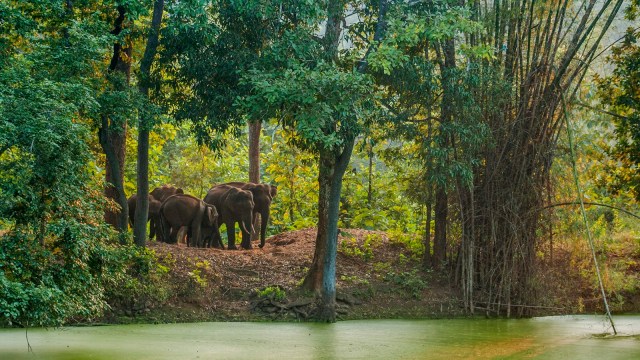The wildlife division of the Union Ministry of Environment, Forest and Climate Change (MoEFCC) recently directed the forest departments of Arunachal Pradesh and Assam to prepare a proposal to notify the Dulung-Subansiri elephant corridor – downstream of the 2000 MW Lower Subansiri hydroelectric project.
The proposal to demarcate the corridor will be presented during the next meeting of the National Board for Wildlife (NBWL), which is the apex government body on wildlife conservation and regulation of development projects in wildlife areas. Notification of the elephant corridor will involve physically marking the relevant areas used by elephants on the ground as well as potentially notifying parts of the corridor as either a wildlife sanctuary or a conservation reserve.

Including the corridor as part of a legally notified protected area will provide legal sanctity to it. An expert committee of the NBWL, which was inspecting the compliance of conditions imposed on the Arunachal Pradesh government, as part of the clearance of the hydroelectric project, had recommended the notification of the elephant corridor in May last year.
The ministry’s directions to the state departments come in the backdrop of the NBWL’s meeting in January this year, which saw deliberations on ways to protect the critical elephant corridor.
During the deliberations, members of the wildlife board concluded that this corridor is important, as it facilitates the east-west movement of elephants across the Subansiri River. The corridor, however, is fragile and requires urgent restoration efforts, they had noted.
ExplainedDulung, Subansiri habitat
The proposal to demarcate the Dulung-Subansiri elephant corridor downstream of the 2000 MW Lower Subansiri hydroelectric project will be presented during the next meeting of the National Board for Wildlife. An elephant corridor is a strip of land that enables connectivity in otherwise fragmented wildlife habitats. They help animal movement and enable genetic exchange which in turn helps in sustaining elephant population.
“Each state could notify the area of the corridor falling in their respective jurisdiction as conservation reserve under Wild Life (Protection) Act, 1972,” H S Singh, an NBWL member, had said, as per minutes of the January meeting. An elephant corridor is a strip of land that enables connectivity in otherwise fragmented wildlife habitats. These are ecologically important as they help animal movement between forest ranges and enable genetic exchange which, in turn, helps in sustaining healthy elephant populations.
The wildlife board’s recommendation to the states was based on the Wildlife Institute of India’s (WII) rapid assessment of the elephant corridor, which looked at the corridor’s functionality to elephants as well as the potential impacts of the hydroelectric projects and related developments on the corridor. The NBWL had commissioned the rapid assessment last year to recommend ways to ensure connectivity between Panir Reserve Forest and Dulung Reserve Forest.
Story continues below this ad
The 2000 MW Lower Subansiri hydro-project, executed by the National Hydroelectric Power Corporation (NHPC), has been in the works since 2003 and is yet to be commissioned. It is located in the Kamle and Dhemaji districts of Arunachal Pradesh and Assam, respectively, and is being constructed on the Subansiri River, a tributary of the Brahmaputra River.
As per the WII’s study, even before the project’s commissioning, the establishment of a residential complex, offices, school, and other recreational spaces by the NHPC has already caused both habitat loss and hindrance to elephant movement. “Numerous commercial establishments and roads have proliferated, adding to the biotic pressure on the already tenuous elephant habitat,” the WII’s report stated.
“The Dulung-Subansiri corridor is functional and of vital importance in the larger landscape for elephants. However, the corridor is tenuous at present and thus needs to be immediately notified and marked on the ground. It is also timely to further strengthen the corridor,” the WII report added.
The WII report had also pointed out that hydropeaking for power generation from the project will pose a threat of sweeping away elephants, especially calves, due to flash floods. “Peaking operations resulting in a sudden increase in water depth by nearly 2.0 meters and accompanied by velocity could increase the risk of elephants, particularly calves, getting swept by flash floods,” the report said.
Story continues below this ad
Hydropeaking refers to regulating the flow of water released from a dam to generate power, depending on demands. Even as the threats posed by hydropeaking were discussed during the NBWL’s January meeting, it has not yet commissioned any hydrological studies, as suggested by the WII, to understand the wider impacts of hydropeaking downstream of the power project.









